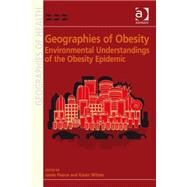- ISBN: 9780754676195 | 0754676196
- Cover: Hardcover
- Copyright: 3/28/2010
Rising obesity rates among both children and adults are a global public health concern. Rates have risen rapidly over the past two decades and by the year 2000 in the United States, 65% of the population were overweight and 30% obese. As a major risk factor for type-2 diabetes, cardiovascular disease and hypertension, excess body weight is recognised as a significant health burden for individuals and health systems in many countries. Geographical and social variations in obesity are also evident. The higher levels of obesity among disadvantaged social groups and in areas of high social deprivation make obesity an important contributor to the widening social and geographical inequalities in health that have been identified in many countries. Although rising prevalence rates of obesity are well documented, explanations for the emerging obesity epidemic, as well as its social and geographical gradient, are more elusive. To date, treatment and prevention approaches have largely focused on individual behaviour - eat less and exercise more. However, individual-level explanations are unlikely to account for the rapidly increasing prevalence of obesity over the past few decades, prompting researchers to consider the external or environmental determinants of energy balance. Environmental explanations can be thought of as "all that is external to the individual". Obesity researchers are increasingly recognising that there are various environmental explanations driving the epidemic including rapid globalisation and urbanisation, and various aspects of the 'built environment' including the pervasive presence of food outlets selling energy-dense foods, as well as urban planning measures that promote car use and limit opportunities for walking and recreation. In combination, these environmental changes have contributed to an increase in energy intake while at the same time sharply reducing the amount of energy we require for basic everyday activities. Adequate theorising and empirical testing of the pathways through which environmental factors contribute to obesity is an essential step to understanding the 'obesogenic' characteristics of the environments in which people live, work, play and go to school. This edited book draws together the international evidence for environmental explanations of rising obesity rates in the developed world and is the first to examine the many ways in which the contexts in which people live their lives promote an imbalance of energy intake over energy expenditure. Whilst it focuses on the environmental or geographical explanations of the 'obesity epidemic', it also demonstrates the importance of multidisciplinary thinking by calling upon the expertise of geographers, nutritionists, epidemiologists, sociologists and public health researchers engaged in obesity-related research. The book is organised into five sections. Firstly, obesity is introduced and defined, the emerging epidemic is documented, and a conceptual overview of the environmental understandings of the disease is provided. Fundamentally, obesity results from an energy imbalance that occurs when energy consumption exceeds energy expenditure. Therefore, the second and third sections consider the two sides of the energy balance equation: 'energy-in' and 'energy-out'. In the energy-in section, the authors consider how various aspects of the food environment are one important contextual driver of rising obesity rates. Conversely, the energy-out section highlights important aspects of the built environment that impinge upon physical activity levels. In the fourth section, the book examines some of the important methodological and technical considerations in undertaking research into obesogenic environments, focusing on which methodologies have hindered and enabled researchers working in this field and, in particular, on methodological advancements that offer new research opportunities. The final chapter in this section considers the importa






